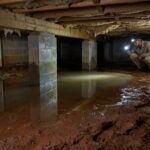Essential Guide to Foundation Repair: Recognizing Signs and Solutions for Long-Lasting Stability
When it comes to home maintenance, foundation repair might not be the first thing on your mind. Between washing the dishes, mowing the lawn, and binge-watching your favorite series, who has time to think about those invisible walls between you and the great outdoors? However, ignoring foundation issues can turn your cozy abode into a leaning tower of… well, maybe not Pisa, but you get the idea. In this essential guide, we’ll explore how to recognize the signs that your foundation needs some TLC and the best solutions to ensure your home stands tall for years to come.
### Understanding Your Foundation
Before we dive into the warning signs and solutions, let’s take a moment to understand what we’re working with. Foundations come in various types – from slab to crawl space – each with its own set of challenges. A foundation is designed to support the weight of the house while also allowing for some movement (because, believe it or not, houses can wiggle a bit). Over time, however, factors like soil erosion, water intrusion, and tree roots can do a number on your foundation’s integrity.
### Recognizing the Signs of Foundation Problems
The first step towards preserving your home’s structural integrity is knowing what to look for. Here are some classic signs your foundation might be throwing a tantrum:
#### 1. Uneven Floors
If your living room resembles a funhouse, it may not just be the drink you had last night. Sloping or uneven floors can indicate foundation settlement or heaving. Take a marble or ball (you know, the kind you used to play with as a kid) and roll it across the floor. If it takes off like it’s in a race, you’ve got a problem.
#### 2. Cracks in Walls
Cracks in drywall or plaster are the classic “uh-oh” sign. If you spot vertical cracks larger than a quarter of an inch or horizontal cracks that resemble a spider web, it’s time to pay attention. Cosmetic cracks? Sure, they happen. But structural cracks? They’re saying “help me” loud and clear.
#### 3. Doors and Windows Are Sticking
Doors that refuse to close properly are akin to moody teenagers—unpredictable and a little jarring. If your doors and windows are sticking or are difficult to open, your foundation may be settling or shifting, altering their alignment.
#### 4. Gaps Around Windows and Doors
If you start noticing gaps around your windows and doors that weren’t there before, it’s likely a sign that your foundation is shifting. Think of your home as a giant puzzle, and the pieces are starting to drift apart.
#### 5. Basement Water Intrusion
A wet basement isn’t just an inconvenience; it can lead to serious foundation issues. If rainwater is finding its way into your basement and setting up a cozy home there, it can erode the foundation walls, leading to further damage.
#### 6. Chimney Separation
If your chimney looks like it’s trying to escape your house, it’s a problem worth addressing. If the chimney separates from the house or begins to lean, it’s typically caused by foundation movement. We like our chimneys upright and supportive, thank you very much!
### The Causes of Foundation Problems
Understanding the causes of foundation issues can often lead us to effective solutions. Here are some common culprits:
– **Soil Conditions**: The type of soil your house sits on plays a massive role in its stability. Expansive clay soil, for example, can swell when wet and shrink when dry, causing your foundation to shift.
– **Water Issues**: Poor drainage or leaking pipes can lead to excess water around your foundation. Too much water can erode the soil beneath it, while too little can cause it to settle unevenly.
– **Poor Construction**: Sometimes, homes are built on foundations that just weren’t up to snuff from the get-go. This could include poor drainage systems, inadequate footings, or using subpar materials.
– **Tree Roots**: While trees are beautiful and provide shade, their roots can wreak havoc on your foundation. As they grow, they can pull soil away or even damage the foundation itself.
### Solutions for Foundation Repair
Now that you’ve identified potential problems, it’s time to take action! Here are some common solutions that can help restore your foundation’s health:
#### 1. Underpinning
Underpinning involves deepening and stabilizing your foundation. This can be accomplished using various methods, such as adding concrete piers or steel push piers. It’s like giving your foundation a solid pair of shoes to prevent it from sinking into the ground.
#### 2. Foundation Slab Repair
For homes with slab foundations, slab repair options include mudjacking or polyurethane foam injection. These techniques lift the slab back to its original position by injecting material underneath it. It’s a bit like inflating a deflated tire—only messier.
#### 3. Crawl Space Stabilization
If your home has a crawl space, consider encapsulation and installing piers to support the beams. This method improves ventilation and prevents moisture buildup, ensuring the foundation remains stable.
#### 4. Waterproofing
If water is intruding on your foundation, waterproofing is key. This can involve installing sump pumps, drainage systems, or applying sealants to keep water at bay. After all, a dry foundation is a happy foundation.
#### 5. Soil Grading
Improving the grading around your home can divert water away from the foundation. A sloped yard might not be ideal for a picnic, but it does wonders for your foundation’s well-being.
### When to Call in the Professionals
While some minor issues might seem manageable, many foundation problems require professional intervention. Not sure when to call the experts? Here are some guidelines:
– If you notice significant cracks (more than half an inch).
– When doors or windows are severely misaligned.
– If you suspect complex issues like soil erosion or tree root interference.
– If water seepage in your basement becomes frequent.
### Prevention Is Key
Like most things in life, prevention is better than cure. Here are a few tips to keep your foundation in tip-top shape:
– **Maintain Gutters**: Ensure your gutters are clean and direct water away from your foundation to prevent pooling.
– **Landscaping**: Be mindful of large trees near your foundation. Their roots can sneakily invade, causing issues.
– **Regular Inspections**: Regularly inspect your foundation for any signs of cracking or shifting, and address issues promptly.
### Conclusion
Your home’s foundation is quite literally the bedrock of your safe haven. Recognizing the signs of foundation problems early and addressing them can save you from costly repairs and a precarious living situation. Whether it’s lifting sagging floors, sealing cracks, or managing water drainage, understanding your home’s foundation needs will go a long way toward ensuring its longevity.
So, the next time you’re lounging on your couch, take a moment to appreciate the sturdy walls around you—after all, they’re standing tall and proud, ready to support all those Friday-night pizza parties and impromptu dance sessions. With a little attention and care, your foundation can continue to be the unsung hero of your household for many years to come.


